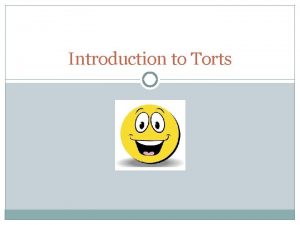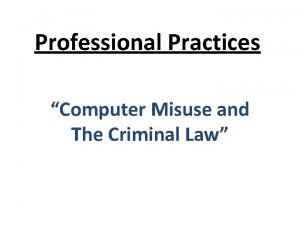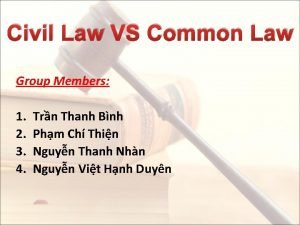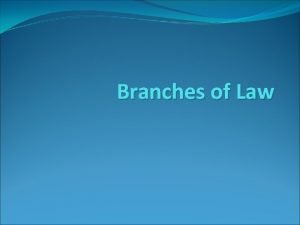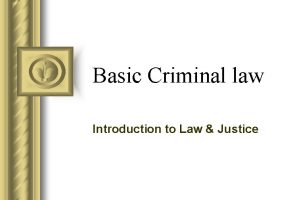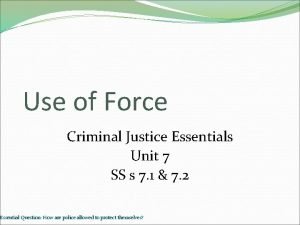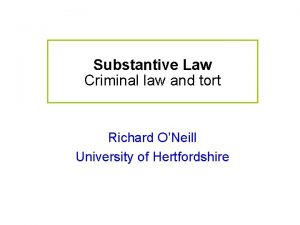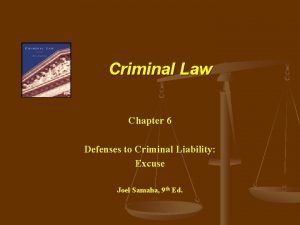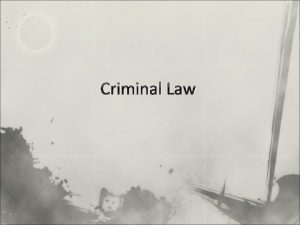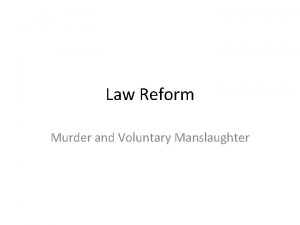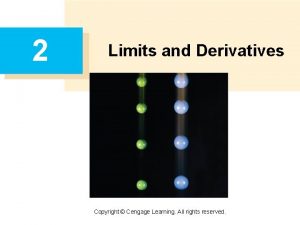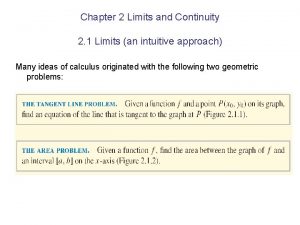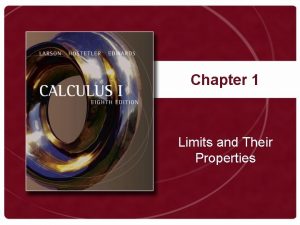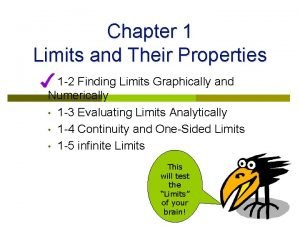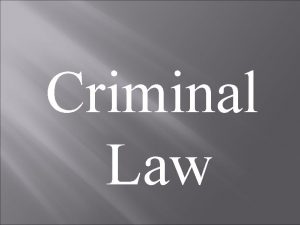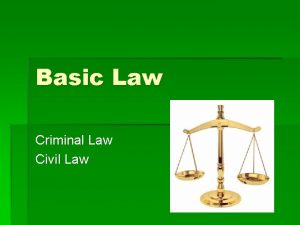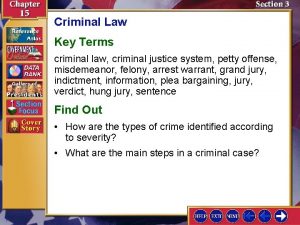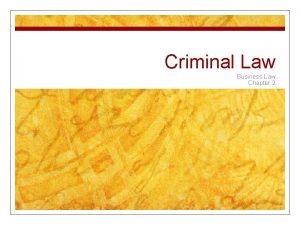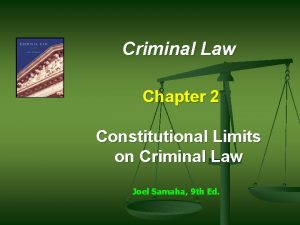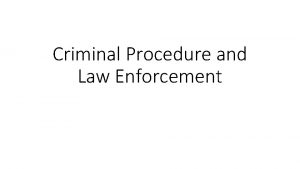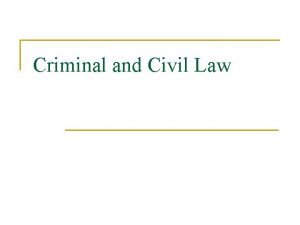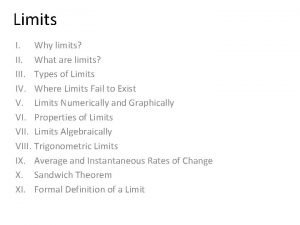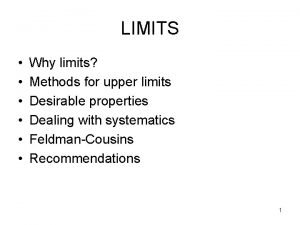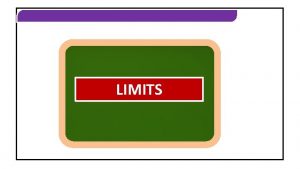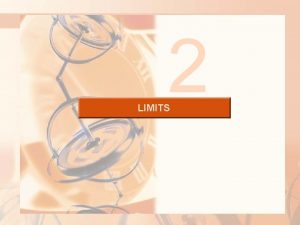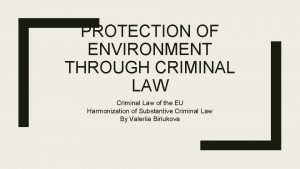Criminal Law Chapter 1 The Nature and Limits

























![Finding Cases n n Example: (State v. Metzger [Chapter 2]), just after the title Finding Cases n n Example: (State v. Metzger [Chapter 2]), just after the title](https://slidetodoc.com/presentation_image/f6c5ebed71046822c8281d707e91e2e6/image-26.jpg)

- Slides: 27

Criminal Law Chapter 1 The Nature and Limits of Criminal Law Joel Samaha, 9 th Ed.

Conduct that Unjustifiably Inflicts Harm n Crime n Noncriminal wrong n Regulation n License n Lawful

Conduct that Unjustifiably Inflicts Harm n Crime n The degree of severity should reflect the amount of stigma that a criminal should suffer and the severity of punishment a person deserves

Conduct that Unjustifiably Inflicts Harm n Non-criminal wrongs (torts) n n “Victims” should sue the actors (a word for parties in legal cases) who injured them, but the stigma of “criminal” should not be attached to the offender. License n Taxes, Licensing, Permits, etc. and pursuing those who violate the laws. Neither encourages nor discourages the behavior.

Conduct that Unjustifiably Inflicts Harm n Lawful n n There are no legal consequences for the act but it can still be deemed deviant behavior by peers and the community. Regulation n Government places this burden on behaviors to discourage them, i. e. , alcohol tax creates a higher user price, but drinking is not a criminal act.

Principles of Criminal Liability n “conduct that unjustifiably and inexcusably inflicts or threatens substantial harm to individual or public interest, ” Model Penal Code, 1985. n A conduct that was committed n Unjustifiably and inexcusably n Inflicts or threatens substantial harm n To individual or public interests

Criminal Law versus Civil Law Criminal Law n Public Wrongs n Prosecuted by the State n Proof beyond a reasonable doubt n Right to counsel n Defendant has right to silence n Penalties or sanctions are based on seriousness of the offense, i. e. , misdemeanors and felonies Civil Law (torts) n Private Matters n Private parties file suit n n Preponderance of the evidence Must hire own attorney Defendant may be forced to testify Penalties based on compensation or remedies

Question What is the most important difference between torts and crimes? Explain how this relates to punishment.

Criminal Punishment “Every criminal law has to define the crime and prescribe a punishment. ” n Criteria for criminal punishment n Inflict pain or other consequences Prescribed within the law defining the crime Administered intentionally Administered by the state as punishment n Limitation: 8 th amendment n n n

Criminal Punishment (Continued) n Prevention (forward looking) n n n General deterrence Special deterrence (specific) Inapacitation Rehabilitation Retribution (backward looking) n An “eye for an eye” captures the idea of retribution

Trends in Punishment n n Historically, societies have justified punishment on the grounds of retribution, deterrence, and rehabilitation. Retribution dominated penal policy until the 18 th century, when it was replaced with deterrence and incapacitation. Rehabilitation replaced deterrence in the late 20 th century and was the major form of punishment until the early 1960 s. By the mid-1980’s retribution and incapacitation were the primary forms of criminal punishment.

General and Specific Parts of Criminal Law n General part of criminal law n n Covers principles that apply to all crimes: constitutional principles found in the U. S. and state constitutions Special part of criminal law n The special part defines specific crimes and arranges them into groups according to the subject matter and seriousness

Crime Classification n Felonies n n Crimes punishable by death or imprisonment in a state facility for life or a period of time. Misdemeanors n Crimes punishable by a fine or a jail term of up to a year in a local facility.

Grading Crimes n n Malum in se Societal Controversy… Inherently evil conduct that has injurious consequences, e. g. , murder, rape, robbery n Malum prohibitum n Conduct prohibited by law because they are not evil in nature, e. g. , dui, tax evasion, speeding, carrying a concealed weapon Every society may disagree on what is “evil” behavior and what behavior “should” be criminalized by society. Examples: 1) Viewing sex offenders differently county by county 2) Different states having different ages at which a child can be treated as an adult for a crime

Definition of Crimes n Crimes against the state: n n Crimes against persons: n n Murder & rape Crimes against property: n n Domestic & foreign terror Stealing & trespass Crimes against public order and morals: n Aggressive panhandling & prostitution

Principle of Legality n Also known as the rule of law n This principle purports that law controls the power of government. n It consists of four values that has existed from Aristotle in 350 B. C to the Magna Carta in 1215, they include: n n Fairness Liberty Democracy Equality

“No Crime Without Law: No Punishment Without Law” l Explain this proposition. The case of Treva Hughes (Hughes v. State, 1994) is an excellent example.

Legislative and Judicial Retroactive Criminal Law Making n n Legislative retroactive law making has a ban imposed on it. One reason for the ban is to allow the rule of law not the rule of officials. Judicial retroactive criminal law making allows judges to exercise their judgment (discretionary decision making) in cases. Limits to law making include: n n n Judges are bound by the U. S and state Constitutions Judges have to follow the rule of lenity and stick Precedent Stare decisis Rule of lenity: implies that when judges apply a criminal statutes to a defendant, they must stick “clearly within the letter of the statute. ”

Sources of Criminal Law n U. S. Constitution n State constitutions n Common law of England & U. S. n U. S. criminal code n State criminal codes n Municipal ordinances n Judicial decisions interpreting codes and the common law

Common-Law Origins n n Criminal codes didn’t spring full-grown from state legislatures. They evolved from a long history of ancient offenses called common-law crimes. These crimes were created before legislatures existed and when social order depended on obedience to unwritten rules: lex non scripta n State common law crimes n n Following the American revolution, the 13 original states adopted the common law. Federal common law crimes n U. S v. Hudson and Goodwin (1812): There are no federal common law crimes, however, there are exceptions, e. g. , the Sherman Act, civil rights legislation, and mail fraud statutes.

Constitutional Limits n Due process of law n n Equal protection of the law n n Legislatures have to write criminal laws that are clear enough for individuals and government officials to know in advance exactly what the law bans. Legislatures cannot define crimes and punishments that apply differently based on inherited characteristics (race, ethnicity, gender, and age). Individual rights and liberties n Legislatures cannot make crimes that violate the rights to free speech, religion, and privacy.

Model Penal Code (MPC) n n n Focuses on the analysis of criminal liability meaning “who is responsible for what. ” After the adoption of MPC in 1962, more than forty states changed their criminal codes. None of the states adopted the MPC completely, but it influenced all of them to an extent, in essence, the MPC is the common denominator in U. S. criminal law.

Administrative Agency Crimes n n These are rules or laws written by administrative agencies, who have been granted authority from both federal and state legislatures to create laws. They are a rapidly growing source of criminal law, but they often raise constitutional questions. Two such questions are: n n Can legislatures authorize administrative agencies to create regulations, when there is a criminal penalty for violating such regulation? Can legislatures allow agencies to set up their own courts to decide cases involving violations of the regulations they have created?

Criminal Law in the Federal System n n There are 52 criminal codes: one for each of the fifty states, one for the District of Columbia, and the U. S. Criminal Code. Definitions, defenses, and punishment of crimes vary across state lines.

Reading Case Law n Facts of the case n Action of the court n Intention of the court n Question - Legal issue(s) involved n Decision n n Affirm Reverse and remand – sent back to lower court Opinion n Majority n n n Concurring Plurality Dissenting
![Finding Cases n n Example State v Metzger Chapter 2 just after the title Finding Cases n n Example: (State v. Metzger [Chapter 2]), just after the title](https://slidetodoc.com/presentation_image/f6c5ebed71046822c8281d707e91e2e6/image-26.jpg)
Finding Cases n n Example: (State v. Metzger [Chapter 2]), just after the title of the case, State v. Metzger, you read “ 319 N. W. 2 d 459 (Neb. 1982). ” Here’s how to interpret this citation: n 319 = First number is always the “Volume number” n N. W. 2 d = Northwestern Reporter, Second Series n 459 = page number n (Neb. 1982) = Nebraska Supreme Court in the year 1982

 What is a civil law
What is a civil law Criminal law plaintiff
Criminal law plaintiff Lim as x approaches infinity
Lim as x approaches infinity Shape 65
Shape 65 Nature and nature's laws lay hid in night
Nature and nature's laws lay hid in night Newton's first law and second law and third law
Newton's first law and second law and third law Si unit of newton's first law
Si unit of newton's first law Computer misuse and criminal law
Computer misuse and criminal law Unit 2 criminal law and juvenile justice
Unit 2 criminal law and juvenile justice Difference between civil and criminal law table
Difference between civil and criminal law table Difference between civil and criminal law table
Difference between civil and criminal law table Mala prohibita
Mala prohibita Example of criminal law
Example of criminal law General defences in tort
General defences in tort What is entrapment
What is entrapment Define substantive criminal law
Define substantive criminal law Example of voluntary manslaughter
Example of voluntary manslaughter Causation in criminal law
Causation in criminal law Diminished responsibility in criminal law
Diminished responsibility in criminal law Law and order vs csi
Law and order vs csi Sandwich theorem examples
Sandwich theorem examples Constant multiple law of limit
Constant multiple law of limit V=k/p
V=k/p Constant of avogadro's law
Constant of avogadro's law Calculus chapter 2 limits and continuity answers
Calculus chapter 2 limits and continuity answers Limits and their properties
Limits and their properties Chapter 1 limits and their properties
Chapter 1 limits and their properties Trig limits
Trig limits

